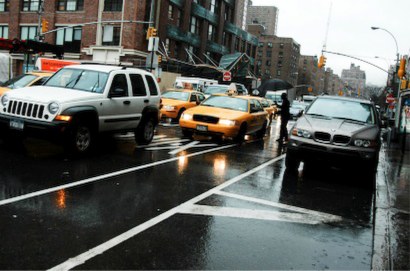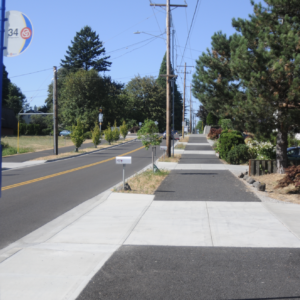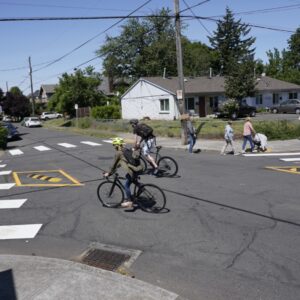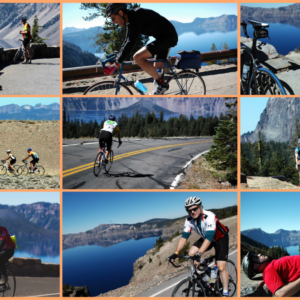“Over the few blocks that I rode, I saw it used in a number of ways, including actual cycling.”
While I was in New York City for a few hours on Wednesday on my way from New Haven to Baltimore, I took the Brompton for a rainy ride down the new 9th Avenue cycletrack. The cycletrack, common in Copenhagen and Amsterdam but still relatively rare in the US, is a bike lane that is physically separated from motor vehicle traffic.
Portland is building a cycle track in the Northeast Cully neighborhood, and new mayor Sam Adams has pledged to build a higher-profile one in his first 100 days in office.
StreetFilms captured some New Yorkers’ first reactions to this cycletrack, the city’s first.
Since then, New Yorkers have incorporated the cycletrack into their daily life. Over the few blocks that I rode, I saw it used in a number of ways, including actual cycling. Below are some photos and more of my thoughts:

The black sign on the left says “Bike Path” and below it is a car in a red circle with a slash through it. Note the deconstructed sharrows. (Photos by Elly Blue)

This section of cycle track is separated by paint and plastic bollards. You bike between the parked cars and the curb, with a nice buffer between yourself and the door zone.

This cycletrack is on the left of a multi-lane one-way street, and at many intersections users have separate signals to protect against left hooks. The person in the car here had a left turn arrow; the cycletrack user in the electric wheelchair had a red light (which he may not have seen, as he was going the wrong way).

Especially contested parts of the cycletrack are painted green, as in Portland. I watched as boxes of liquor were unloaded from this truck for at least ten minutes. Only two people biked by — this was during a downpour.

This lady stepped off the curb and the taxi driver pulled into the green bike lane with one fluid motion.

This part of the 9th Avenue lane isn’t separated, and it feels a lot different. You’re squeezed between parked cars and regular traffic, and are competing for space with taxi customers, among others.
See the Streetswiki entry on Physically Separated Bicycle Lanes for more on the difference between separated and unseparated bike lanes.











“Over the few blocks that I rode, I saw it used in a number of ways, including actual cycling.”
this made me smile:)
i swear bike lanes in this city are sometimes used by everything other than bikes. separation is key but then again space is such an issue and sometimes so much so that there is conflict.
more on our own brooklyn bike lane conflict – http://brooklynbybike.wordpress.com/2009/01/08/a-bike-lane-fight-grows-in-brooklyn/
I’ve seen that cycletrack in NYC…its enormously wide….in a very crowded city. Anita’s right…so much empty space will eventually be used/misused for other purposes.
however I don’t think New Yorkers complain as much about it as Portlander’s would…living in NYC requires a certain dexterity that doesn’t exist in the PNW..
Second pic from top: allowance for a door zone is a great idea, but space being allowed in this situation seems excessive (a visual trick of the camera, perhaps?)Any particular reason for this? Also, same pic: any idea what each of those smaller, marked lanes to either side of the bike lane are?
Nice to get some views of an ordinary day in NYC.
That last photo reminds me of SW Broadway in Portland, a street that desperately needs the kind of treatment they’re doing in NYC.
As I said, such a magical, wacky corridor brimming with insouciant humanity!! I just rode down it about an hour or two ago. We’re definitely still in the learning stage with this cycle track. I find it very slow going. I almost prefer the dangers of the road to the interruptions of this cycle track, but I like it when its dark. I’ll stop taking it once the days get longer.
Vehicles on 9th Avenue making left hand turns are still confused by the difference between bike and car signals. I think some people are so hyped up that they just see green and then go. You cannot underestimate how aggressive drivers are in NY. People will burn two dollars of fuel to gain a centimeter over the next car. I suppose it will take a long time for them to get used to this kind of a cycle track. If there were cycle tracks throughout the city to accustom drivers and pedestrians more frequently to the way things should work, I’d be more hopeful that drivers would stop turning left into the bike lane when they should be waiting or that people would stop hailing a cab from the middle of the bike lane and so on and so on (not including wheelchair operators. They get a pass in my book).
The area where the liquor truck was unloading is normally blocked with a huge postal truck. Every single weekday around 5:15. But the cycle track ends right at that point, so the divide between street parking and bike path no longer effectively deters such a thing. It becomes a regular bike path with a negligible striped buffer zone from 15th to 14th Street. And the intersection of 14th and 9th is terrible. Lots of left turning cars and double parked cars in the bike path (the double parked car is an institution here). At this point I just ride with traffic in the far right hand lane.
The cycletrack isn’t enormously wide. Don’t blame the cure for a pathology. It’s the way it should be and its size has less to do with misuses than the general way things function in NY. Ninth Avenue isn’t one of the more pedestrian-filled avenues so there aren’t a lot of times when the sidewalk is so packed that the bike path is more desirable. People just do whatever they want here without much consideration for the way things should function. This ambiance has its appeals but there has to be a middle ground between safety/efficiency and a vibrant urban character. The velotopia should not be totalitarian and infrastructure is only as successful as the culture that embraces it.
According the Transportation Alternatives, there have been many safety benefits for both cyclists and pedestrians in the short time of the cycle track’s existence, but it’s still frustrating when like tonight there was a sanitation truck blocking the path. But what are the sanitation workers really supposed to do? I can’t imagine them dragging the trash cans out to the car lanes.
Welcome to NYC. Have fun and safe travel.
It’s good to get these pictures out of US cities implementing cycletracks because I know some bike organizations here in the US don’t understand them. So thanks for the photos.
I must point out that this looks absolutely nothing like the typical cycle path in the Netherlands.
What you have here looks quite a lot like what is being removed in the Netherlands.
A couple of photos to demonstrate. This is old and this is what it leads into and is in the newer style.
You can see both of these in use in a video here.
I don’t know for sure, but I suspect that one reason for its width is so that it can be accessed by emergency vehicles.
There is a similar cycle track here in Baltimore — it is two way, and is separated from a mega one-way street by orange bollards. I’ll have some photos up soon. It is also wide enough to allow emergency vehicles, but during my time on it I saw a taxi taking a shortcut, a minivan picking up kids, and two city vehicles parked on it. There does need to be some kind of greater visual and physical separation.
David, thanks for the perspective and photos of how it ought to be! Are you listening, Portland?
4 meters/12′ wide: that would definitely be beneficial. Completely separated is probably more enjoyable and safer to ride on(and more expensive to build), but the use of the concrete bumpers (link, comment #7 ‘old’)to help designate lanes would seem to be a reasonable means for many streets. Also, they would allow a more efficient use of roadway, in addition to possible use of the lane by motor vehicles in case of emergency.